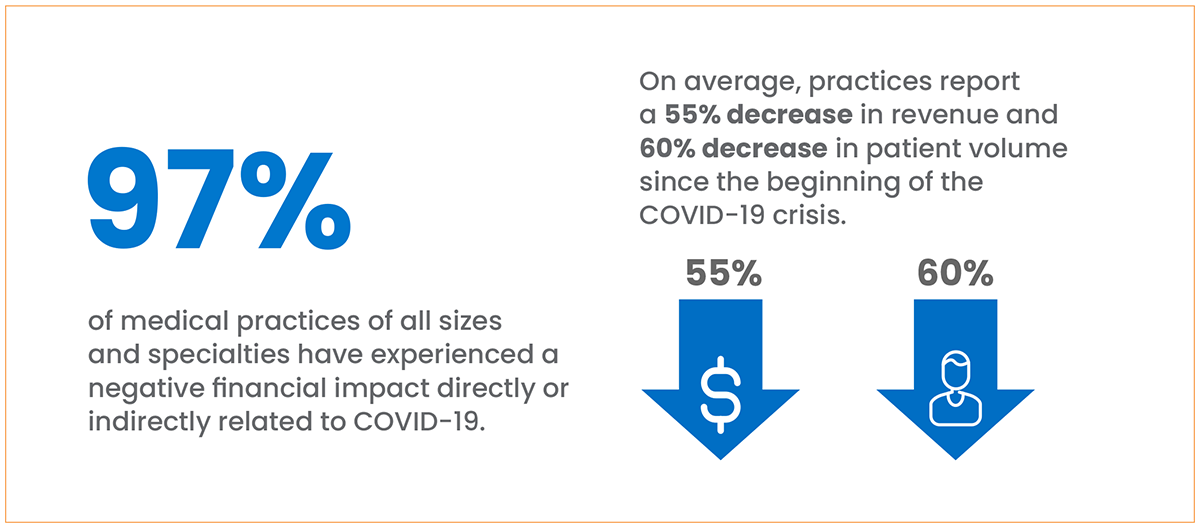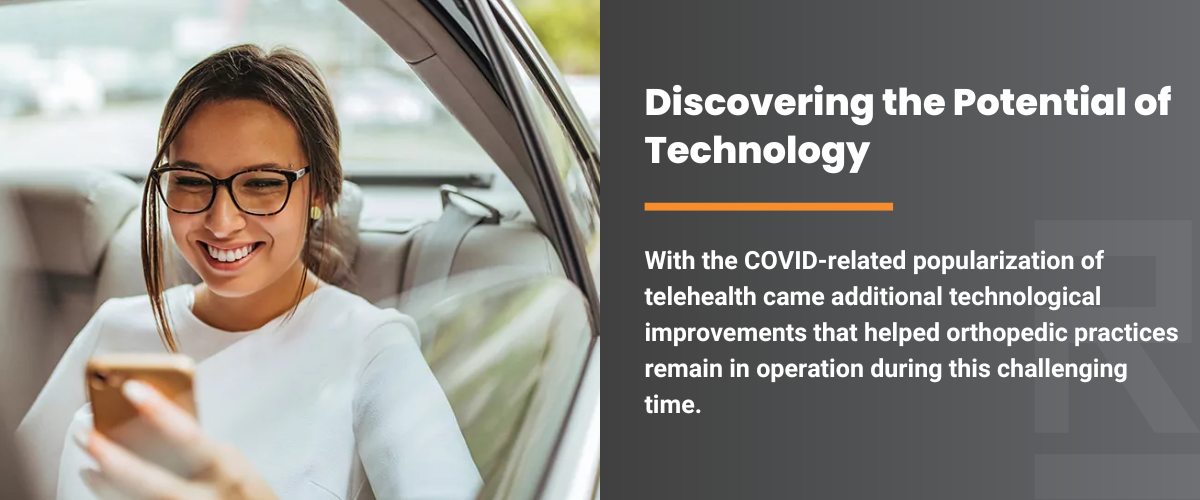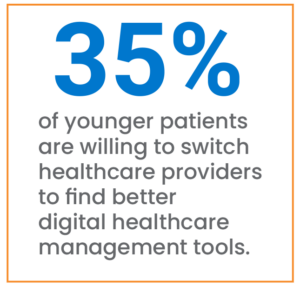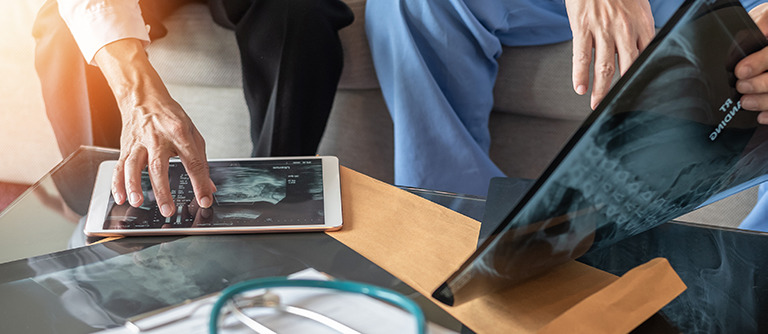How Practices Are Moving Forward with Healthcare Technology Solutions
As orthopedic practices continue to navigate new processes to best serve their patients during COVID-19, technology stands at the forefront of this journey. While implementing new technology may have once seemed like an aspiration, now it’s essential to providing a full range of care. Offerings like telehealth and digital healthcare management solutions have not only enabled orthopedic practices to continue to see patients during the pandemic, but these tools have also provided the engagement and flexibility that patients have come to expect. Pivoting to these digital solutions hasn’t always been attainable for orthopedic practices—partially due to implementation attitudes, reimbursement issues, and government regulations—but the pandemic has been the catalyst to do so. The response has been resoundingly positive from providers and patients alike, creating a sense of enthusiasm for new technology that is increasing in popularity. The journey to adoption, however, hasn’t been without its challenges. A webinar sponsored by Rectangle Health and hosted by Becker’s Healthcare investigated the obstacles orthopedic practices faced when being forced to implement new technology that reduced face-to-face contact at the onset of COVID-19. This webinar, entitled “Meeting Patient Expectations in Surgery Centers and Orthopedics,” was hosted by Brian Zimmerman, on behalf of Becker’s Healthcare, who interviewed the following panelists:
- Nick Bohra, Chief Financial Officer at Pain Specialists of America
- Brian Doyle, Vice President at Rectangle Health
- Joe Mitchell, Director of Finance at Colorado Pain Care
- Cindy Murray, Chief Operating Officer at OrthoTexas Physicians and Surgeons
- Tamara Porfirio, Chief Operating Officer at Weil Foot and Ankle Institute
- Tim Spooner, President and Chief Executive Officer at Spooner Physical Therapy
These panelists discussed how their organizations came to realize the value of technology—and how they will continue to embrace it—in their quest to meet patients where they are most connected.

Finding Opportunity within Chaos
Orthopedic practices experienced many friction points when COVID-19 first hit that required an immediate response. How could these organizations provide care when in-person contact was limited and digital care options were not yet approved or implemented? According to Tim Spooner, “We had to address how we were going to interact with our patients who still needed our services. The pain didn’t go away during COVID.”1 As practices watched their patient volume rapidly decrease due to triage rules that classified many surgical procedures as optional and physical therapy appointment cancellations soared, physicians had difficult decisions to make about how they would proceed with providing care. Facing delays for surgical procedures that were important yet not life-threatening, patients had to wait for an often uncertain amount of time to get the care they needed.
Lockdown associated with COVID-19 had a detrimental effect on orthopedic treatments for patients with chronic conditions. According to Nick Bohra, “We had to figure out in addition to dealing with the how do we see our patients, how do we provide them care? And how do we take care of them while we’re not able to physically see them during lockdown?”1 Because Bohra’s company, Pain Specialists of America, specializes in treating patients with chronic pain issues, the lockdown presented a unique challenge that couldn’t easily be resolved.
Telehealth was an option, but many physicians couldn’t yet receive full reimbursement for it and certain government restrictions limited its availability and usage. In Texas, for example, telehealth wasn’t initially approved as a viable treatment option, so local offices had to improvise when they saw patient volume decrease. And there was the fact that physicians couldn’t perform surgeries through virtual visits, so while telehealth was an improvement, it wasn’t a panacea.
Telehealth did eventually catch on, though, streamlining patient care as much as it could, and orthopedic practices began to realize that the answer to their conundrum could be found in the adoption of technology. As reimbursement restrictions for physicians using telehealth were lifted, the service was popularized as an alternative to in-person care. There could now be an almost complete, end-to-end digital experience, from filling out required administrative paperwork to seeing patients to paying for visits—all these options could be digitized to the satisfaction of many consumers. Another surprise was the ease of technological implementation many practices experienced, allowing them to connect with their patients in a more engaging way.

Discovering the Potential of Technology
With the COVID-related popularization of telehealth came additional technological improvements that helped orthopedic practices remain in operation during this challenging time, but did these practices have the capacity to implement them as quickly as would be needed? Solutions that limited physical contact between patients and staff were prioritized. According to Cindy Murray, “We literally had to pivot within about 48 hours and make some changes to our practice that we never anticipated.”1 These changes Murray refers to included introducing telehealth, cross-training staff to take on different roles, and directing staff to work remotely to keep all parties as safe as possible.
There were other patient-facing improvements. In response to new guidelines that addressed ongoing health and safety concerns, practices had to act fast to adapt, which often involved utilizing digital resources to make technology available. According to Tamara Porfirio, “Before COVID, patients had to complete registration at our electronic kiosks. […] We implemented contactless check-in so patients could let us know when they arrived through their smartphone. […] We essentially established a virtual waiting room.”1 These options were significant improvements that helped orthopedic practices function during an ever-evolving crisis, paving the way for a hybrid end-to-end digital experience.

The technological adoption didn’t stop there. Contactless payments provided much-needed risk mitigation for both patients and staff. According to Porfirio, “By accessing [online payments] and Text-to-Pay, we really improved our revenue capture.”1 Customizable messages also proved effective for practices that needed to communicate with patients in real time. Murray states “We did a lot of on-demand messaging, just letting patients know we were open and […] it is safe to come in. We made sure that they were aware of all of our new policies and procedures that we had implemented related to keeping them safe as well as keeping our staff safe.”1 These solutions allowed orthopedic practices to reduce physical contact associated with care, conveying transparency to patients about best practices for safety.
When it came time for orthopedic offices to re-open, many made use of videos to show how their office was adhering to safety guidelines put forth by the government. Patients were quite receptive to this form of communication. According to Murray, “Videos of our physicians, of how the clinics operated, went a long way in giving patients comfort while giving them the ability as well to do follow-ups through telemedicine.”1 These videos created a new layer of connection that engaged patients and informed them about often-changing in-office safety protocols.
Activating tools like company websites and social media was instrumental in improving digital marketing efforts and patient-provider communication. Orthopedic practices found immense value in scaling up their digital teams to manage this process improvement. According to Spooner, “We spun up an internal digital team, and they were able to connect us with our audiences through social media [and] through our website […] in ways that we had not done before. And that was a real key to our success.”1 Making use of these electronic resources connected practices to their patients, promoting engagement that helped both parties to function during a crisis.
Obstacles on the Path to Adoption
Although orthopedic practices were quick to put digital solutions into place at the onset of the pandemic, internal forces have historically been hesitant about adopting new technology. According to McGrath et al. (2021), “Providers and healthcare systems have traditionally viewed technology as an additional asset, or even a burden in some cases rather than a necessity.”2 This view, often hinging on competing priorities and lack of pressure to implement, held many orthopedic practices back from realizing the full potential of technology. COVID-19, however, provided that needed pressure, pushing organizations to realize that technology is not just an afterthought but a pivotal connection point that would revolutionize care in the months to come.

Many orthopedic practices shifted their workforce offsite to comply with safety guidelines. This transition, however, was not always seamless. According to Porfirio, “It was very new for our leaders to now lead in a virtual/remote world, and also for our staff to learn how to function […] in some ways, independently.” 1 There was also the question of how to measure employment-related productivity in a remote workplace. According to Bohra, “With everybody remote […] we needed better productivity measuring tools in place that could help ensure that the […] work was getting done, whether it was a biller or call center personnel, they were working from home and answering phone calls.” 2 Adjusting to a new, digital workplace may have been challenging for many—especially given HIPAA complexities—but with managing safety concerns ranking high as priorities for orthopedic practices, changes had to be made for the greater good of the organizations.
Although orthopedic practices were previously aware of digital payment processing solutions, there had been hesitancy about implementing them. Before COVID-19 took hold, practices questioned how patients would react to this implementation. Many organizations wondered if their patients would embrace these solutions or reject them. This uncertainty made adoption seem like a leap not entirely worth taking.
Contrary to these concerns, patient adoption of digital healthcare management solutions is extremely high, especially among younger patients. As bridge millennials and millennials have grown up with technology playing a major role in their education, professions, and community, they have also come to expect it from their healthcare providers.
Convenience associated with using digital payment processing solutions has been a contributing factor to the effort to improve patient experience and satisfaction. According to Rectangle Health, “Leveraging the latest digital payment options means that instead of mailed statements and phone calls, patients can pay their bills online using a computer, tablet, or their mobile device when it is most convenient for them in their day.”4 By continuing to utilize technology to connect with patients, orthopedic practices can create a more meaningful conversation with patients about care and payments, leading to increased patient loyalty.
Implementation Insights
Attitudes about technology from internal stakeholders have evolved over the course of the pandemic to become more enthusiastic. Technology that might have initially been viewed as burdensome and additional work became essential to daily practice operations. Installation that was once perceived as time-consuming and complicated was easier than expected and served to convince practices that there was a way forward during a tumultuous time. This was new terrain, however, that practices needed to experiment with before finding success. According to Joe Mitchell, “When we made all these switches to […] electronic patient referrals and intake and virtual waiting rooms, […] I saw amazing results from it.”1 This adoption success unlocked potential for growth and innovation that abounds.
From a patient’s perspective, adjustment to advances in technology was generally easy, with a few exceptions. Some patients didn’t have videoconferencing resources or if they did, they may not have known how to use them. Overall patient technology adoption rates were high, though, for not only telehealth but for other digital healthcare management improvements. As mentioned by Doyle in regards to digital payments, “Patient adoption is skyrocketing. I think it’s only going to get stronger as these technologies become more and more commonplace in the industry.”1 As orthopedic practices continue to make use of technology, the patient journey could see additional changes that create more transparency and offer further flexibility with regard to both care delivery and paying for services.

This rapid technology adoption at the practice level spurred a consumer movement among younger, otherwise loyal patients. According to PYMNTS, “35% of bridge millennials and younger patients are willing to switch healthcare providers to find better digital healthcare management tools.”3 The expectation that practices should offer their patients the latest technology to maintain their loyalty has put even more pressure on providers to adapt. The question is, will these practices continue to embrace technology when the pandemic eases?
Embracing New Technology for Orthopedic Care
Even though orthopedic care can’t be completely virtual, much of the patient experience lends itself to this care model. Of course, physicians can’t perform surgery on a virtual platform, but they can see patients for follow-up visits, communicate internally and externally, and process payments this way. These procedures, however, are only the beginning of what could be a technological revolution that could elevate orthopedic care to innovative new heights.
The road ahead isn’t without its detours, but there is a tremendous opportunity for growth. According to McGrath et al. (2021), “While barriers to adoption exist—including reimbursement and operational efficiencies—the orthopedic community is on track to have virtual care and telemedicine as a new normal long after the pandemic has come to an end.”2 Will insurance companies and HIPAA continue to promote the use of telehealth in the orthopedic space after the pandemic? Early predictions look promising. This finding also suggests that there is room for other technological solutions that may include virtual and augmented reality (VR and AR) and wearable sensor devices to improve the orthopedic experience.
Wearable devices can be tremendously useful for physicians who want to monitor their patients remotely. According to Bini et al. (2020), “Wearable sensor devices (WSDs) may play a significant role in the emerging age of Digital Orthopaedics. WSDs typically include accelerometer, gyroscope, and global positioning sensors that can track position, movement, acceleration, and vital signs such as temperature and heart rate.”5 These tools are often economical and allow physicians to offer an expanded suite of virtual care options to patients.

Virtual and augmented reality are other technological innovations that can drive continuous improvement in orthopedics. According to Bini et al. (2020), “VR provides users with immersive, interactive experiences in computer-generated environments through the use of a headset and body motion sensors and typically, hand controllers, in the current generation of commercially available platforms. VR and AR can deliver sophisticated simulations and immersive environments for remote PT and surgical training.”5 Orthopedic practices can benefit from implementing VR and AR for internal training and physical therapy for patients because these options add another layer to virtual care that can be utilized during the pandemic and afterward.
A Promising Road Ahead
Despite roadblocks associated with COVID-19, many orthopedic practices have not simply functioned but flourished due to their willingness to embrace technology in a nimble way. Their quick pivots to solutions like telehealth and digital end-to-end payment processing have positioned these practices for continuous improvement and success, especially regarding customer experience. The panelists believe that their practices, and the orthopedic specialty in general, will continue to embrace opportunities to implement technology even when COVID-19 dissipates. According to Porfirio, “We are definitely open to and have been adopting tech faster than we would have normally done.”1 This enthusiasm for technological adoption has the potential to elevate the patient’s healthcare journey in the future.
A complete healthcare technology solution for orthopedics
With customized solutions for the orthopedic specialty, Rectangle Health has been providing healthcare payment technology to providers for nearly 30 years. Our Practice Management Bridge® platform offers all-encompassing payment tools, including online payments, Text-to-Pay, flexible payment plans, and office efficiency tools, such as customizable text messages, that help offices easily communicate with patients, receive more payments, and operate more smoothly. Rectangle Health, a leading healthcare technology company, empowers practices with seamless and secure solutions to drive revenue by increasing patient payments and streamlining practice management. Since 1993, the company’s innovative technology has reduced administrative burden and rebalanced the ledger for its thousands of healthcare providers in the U.S., reliably processing over billions of dollars in payments annually. To learn more about how our technology solutions can work for you, schedule an appointment with one of our Practice Management Consultants.
References
- (2021, August 3). Meeting patient expectations in surgery centers and orthopedics webinar. Rectangle Health.
- McGrath, M., Spira, B., Grady-Benson, J., Bruning, P., Kress, K., Belniak, R., Golladay, G.J., and Dhanur, D. (2021). The impact of the COVID-19 pandemic on physicians’ perception of digital health in orthopedics. Journal of Orthopaedic Experience & Innovation.
- PYMNTS and Rectangle Health. (2021, August 4). Connected healthcare: What consumers want from their healthcare customer experiences.
- Rectangle Health. (2021, March 1). How digital payment tools can repair a fractured revenue cycle. Rectangle Health.
- Bini, S.A., Schilling, P.L., Patel, S.P., Kalore, N.V., Ast, M.P., Maratt, J.D., Schuett, D.J., Lawrie, C.M., Chung, C.C., and Steele, G.D. (2020, April 22). Digital orthopaedics: A glimpse into the future in the midst of a pandemic. J Anthroplasty. doi: 10.1016/j.arth.2020.04.048
- Medical Group Management Association. (2020) COVID-19 financial impact on medical practices. Medical Group Management Association.



